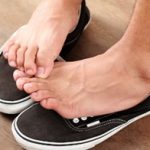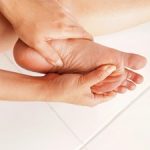 Walking is a simple exercise most of us do daily. Walking gets us from point A to point B, whatever those points may be. Walking can be done by just about anyone and is a good way to improve your fitness and health. But when walking becomes painful we may try to avoid it, thus resulting in a more sedentary life.
Walking is a simple exercise most of us do daily. Walking gets us from point A to point B, whatever those points may be. Walking can be done by just about anyone and is a good way to improve your fitness and health. But when walking becomes painful we may try to avoid it, thus resulting in a more sedentary life.
If you walk every day, you can receive such benefits as improved heart health, healthy weight and a lower risk of dementia and osteoporosis. But if you can’t walk due to pain, then you are greatly putting your health at risk. Below are common reasons why it may hurt to walk and what you can do about it.
Advertisement
4 reasons it hurts to walk
Lumbar strain
 Walking should not result in lower back pain, but the overuse of the lower back can. When the tendons and ligaments which surround your spine are overworked you run the risk of “throwing out your back.”
Walking should not result in lower back pain, but the overuse of the lower back can. When the tendons and ligaments which surround your spine are overworked you run the risk of “throwing out your back.”
To prevent worsened pain from occurring while you walk, you should work on preventative back pain treatment. While walking engage your core – pull your belly button towards your spine as if someone was about to punch you. If you’re walking up or downhill, avoid bending at the waist and try to maintain an upright posture.
Plantar fasciitis
 A band of tissue runs from the heel to the ball of your foot – this is called the plantar fascia. Tiny tears in the plantar fascia can lead to pain because the band stiffens. Walking can worsen this pain, which you can feel occur in your heel or arch.
A band of tissue runs from the heel to the ball of your foot – this is called the plantar fascia. Tiny tears in the plantar fascia can lead to pain because the band stiffens. Walking can worsen this pain, which you can feel occur in your heel or arch.
When your foot begins to feel tight, work on loosening the tissues by stretching out the arch. Wearing protective footwear can also help prevent future plantar fasciitis from occurring. You may even be recommended by a doctor to wear orthotics, depending on your arch.
Ingrown toenail
 Pressure caused by an ingrown toenail can make walking quite painful. Ingrown toenails can develop for many reasons, like improperly cut or uncared for toenails hitting the front of your shoes.
Pressure caused by an ingrown toenail can make walking quite painful. Ingrown toenails can develop for many reasons, like improperly cut or uncared for toenails hitting the front of your shoes.
If you want to prevent an ingrown toenail and the pain associated with it, ensure your shoes have some wiggle room for your toes so they are not pressed up at the front of the shoe. When cutting your toenails, also ensure they are cut straight across and not rounded as you would your fingernails. Furthermore, if you have diabetes or a circulation problem, ensure you get a podiatrist to cut your toenails to avoid complications.
Bunions
 You can spot a bunion just by looking at your foot as the bones and joints become misaligned, which causes them to swell. Bunions are exceptionally painful when you are wearing closed shoes, and the rubbing leads to more irritation. Bunions most commonly occur in people with flat feet, low arches or arthritis.
You can spot a bunion just by looking at your foot as the bones and joints become misaligned, which causes them to swell. Bunions are exceptionally painful when you are wearing closed shoes, and the rubbing leads to more irritation. Bunions most commonly occur in people with flat feet, low arches or arthritis.
To treat and prevent bunion pain wear wider shoes or apply a bunion cushion on the affected area. Icing it after walking can also help bring down swelling and pain. If the bunion is severe, surgery may be required and could keep you off your feet for weeks. If you want to prevent a bunion, ensure you wear comfortable, properly fitting shoes.
Related Reading:
Do these 7 things to live without pain
Throughout the course of our lives we have all experienced pain. Whether due to injury or illness, we all have felt pain. But shocking numbers now reveal that over 25 million Americans suffer from chronic pain. Continue reading…
Advertisement
A recent analysis of data collected from the 2012 National Health Interview Survey (NHIS) give a detailed breakdown of pain in America. This analysis was conducted to add new scope to our understanding of pain and also to shape future research, development, and targeting of complementary health approaches and effective pain interventions. Continue reading…
Sources:
http://www.prevention.com/fitness/fitness-tips/solutions-10-biggest-walking-pains
http://www.tescoliving.com/health-and-wellbeing/fitness/2013/october/top-10-health-benefits-of-walking-everyday
